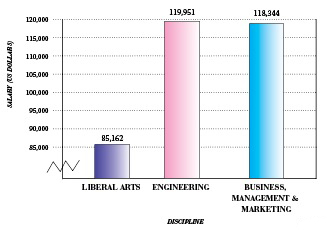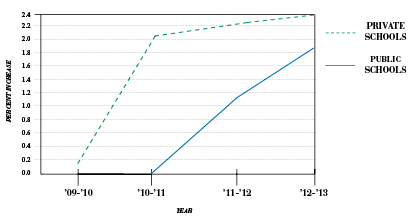The median salary for tenured and tenure-track faculty members increased 2.1 percent in 2012, according to a study released yesterday by the College and University Professional Association for Human Resources. The study also found that for the past four years, faculty members at private institutions have recieved higher salaries than those in public institutions.
The increase was the highest at doctoral institutions, at 2.5 percent. Baccalaureate institutions were came in second with 2.1 percent, and master’s institutions in third with 2 percent.
The study compiled data by discipline and includes four-year colleges and universities. Part-time faculty members were not included in the survey.
 Faculty members at private colleges and universities saw a 2.4 percent increase in salary while those in public institutions saw a 1.9 percent increase.
Faculty members at private colleges and universities saw a 2.4 percent increase in salary while those in public institutions saw a 1.9 percent increase.
NYU spokesman Philip Lentz said salary increases for NYU faculty were higher than 2.1 percent. Lentz said that according to the Almanac of Higher Education 2012, the average salaries of NYU professors placed well above the median of over 1,200 universities surveyed. The salaries for full-time NYU professors were in the 98th percentile, with salaries for associate professors in the 91st percentile and assistant professors in the 96th percentile.
“NYU is proud to recruit and retain top scholars, which benefits students directly, and offer them competitive salaries and benefits,” said Lentz. However, he acknowledged that salary does vary by field.
“It is true that faculty salaries vary by discipline to discipline and that faculty compensation is market-driven,” he said.
The study highlighted the discrepancy in faculty salaries between different disciplines. For example, a professor of journalism and communications earns on average $87,353 a year while a professor of law earns $142,033. The disciplines with the highest salaries are law, business and engineering, and the average for a professor across all disciplines is $95,224. The lowest salaries at private institutions are theology, parks and recreation, and homeland security, while the lowest at public institutions are visual and performing arts, English and history.
“There are definitely great disparities in salaries at NYU for many reasons,” said Jane Burbank, CAS professor of history, and Russian and Slavic studies.
CAS professor Hasia Diner, who teaches religious studies, attributes this gap to the rank of different fields and the popularity of the schools that offer those fields.
“Engineers, business faculty, law faculty can earn much more on the outside and have to be attracted to the academy,” Diner said. “Unfortunately, historians, philosophers [and] professors of literature cannot and therefore don’t have to be lured in. They don’t have obvious and lucrative alternate sources of income. Do I like it? No. It seems outrageous and unfair, but it reflects the realities of the marketplace.”
The CUPA-HR survey is one of two surveys on faculty salaries released each year.
A version of this article appeared in the Tuesday, March 12 print edition. Tatiana Baez is university editor. Email her at [email protected].






















































































































































